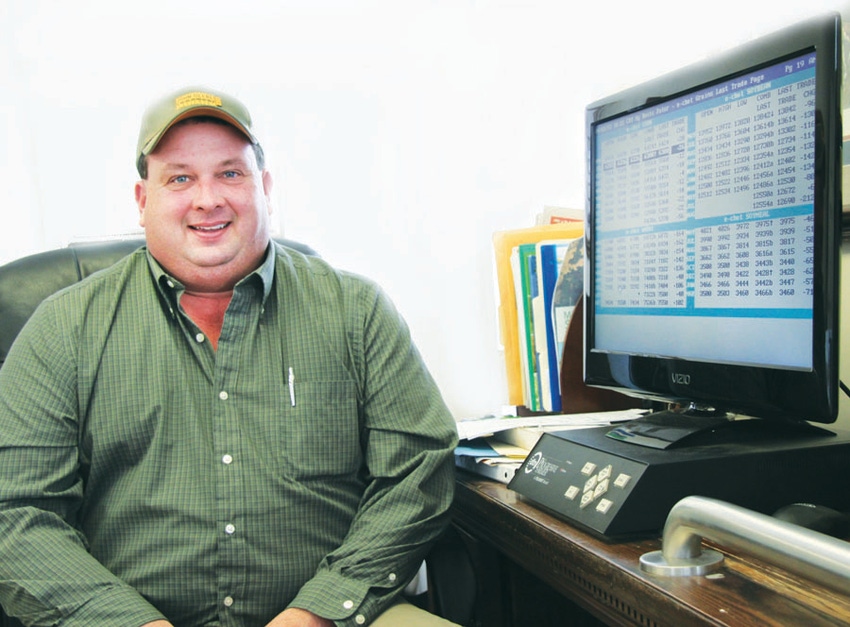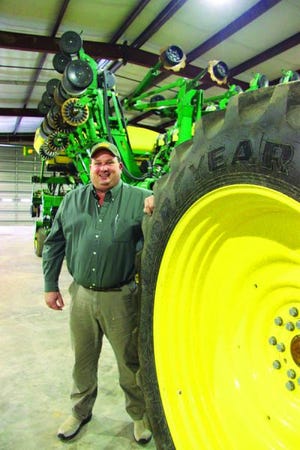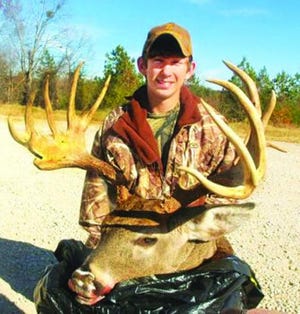
“Cotton put us where we are today,” says Kevin Simpson, who farms in Benton and Marshall Counties, Miss. “But in 2012 grain prices were just too good and we rolled all our cotton acres into grains. We won’t have any cotton this year for the same reason: grain prices continued to be the most attractive option, and we’ve done quite a bit of early booking of this year’s production."

For most of Simpson Farms’ history, going back to Kevin Simpson’s grandfather’s time, cotton has been the backbone crop — but this year the economics again favored grains and he will plant no cotton on the 3,500 acres he farms in two far north Mississippi counties adjoining the Tennessee state line.
“Cotton put us where we are today,” says Kevin, in a rare moment of relaxation at his Ashland, Miss. headquarters, as he waits for rains to end and soils to dry enough to begin planting this year’s crops.
“But in 2012 grain prices were just too good and we rolled all our cotton acres into grains. We won’t have any cotton this year for the same reason: grain prices continued to be the most attractive option, and we’ve done quite a bit of early booking of this year’s production.
“This year, we’ll have 1,000 to 1,200 acres of corn, with the remaining 2,300 to 2,500 acres in soybeans. About 1,400 acres of the beans will be double-cropped behind wheat.”
When they grew cotton, Kevin says, yields for the dryland crop were 900 lbs. to 1,100 lbs. year-in, year-out. But for their last few years of cotton, their harvest operation was somewhat unique for the Mid-South.
“We own land in Texas, which is used mostly for recreational purposes and CRP, although some of the cotton land is rented,” he says. “My father, Danny, who died last August, was a natural-born PR person and he got to a know a lot of the farmers out there. We visited several of their farms and were impressed with how efficient their strippers were in harvesting cotton. They’re very fast — you can dump a load of cotton every few minutes.
“We saw no reason why it wouldn’t work as well here. We bought a John Deere 7455 stripper and modified the gin — we’re a partner in Farmers Gin at Ashland —with a stick machine. The stripper brought a new level of efficiency to our harvesting operation, and when the cotton was picked and ginned, we couldn’t tell the difference between stripper-harvested and conventionally-harvested cotton.
“At whatever time we go back into cotton, we’ll continue stripper harvesting. I’m hoping by that time they will have developed even better stripper heads, which will make the process even more efficient.”
He’s also hopeful there will continue to be enough cotton acreage in the area to keep the gin in operation until the demand for cotton returns.
“The sharp cutbacks in cotton acres the last couple of years have been tough for the ginning business,” Kevin says. “We ginned only 1,740 bales last year, a big drop from the usual 8,000 to 12,000 bales. Owning a gin is a lot like owning a golf course,” he laughs. �“It takes a lot of money to run it. I think we’ll continue to have enough cotton in the area to keep the gin running. With cotton prices now in the mid-80s, that could be an incentive for area farmers to boost their acreage a bit.”
Increasing irrigated acreage
Driving the winding, twisty Highway 5 that runs through steep, wooded hills from Hickory Flat to Ashland, inone of the state’s most sparsely populated counties — in the 2010 census, Benton County ranked 76 of 82; Ashland, the county seat, had a population of 569— one wonders that there is farming at all.

KEVIN SIMPSON will have 3,500 acres of grains on his Benton County, Miss., farm this year. But after 17 years in the sod business, that operation was discontinued and the land converted back to row crops.
But the northern portion of the county, less than 20 miles from the Tennessee line, has quite a bit of open land, with several large-scale farming operations.
“A lot of folks don’t know there’s farming in this area of the state,” Kevin says, “or that there are quite a number of center pivot operations on farms here. We just quietly do our own thing. We installed the first center pivot system in this area on one of our farms in 2008.
“We have about 20 different farms in Benton and Marshall Counties, all within a 10-mile radius of our headquarters. The largest is 600 acres, the smallest less than 10 acres.
“We now have about 500 acres that we irrigate with four Valley center pivots, all fed from wells. We have to drill to about 350 feet to get an adequate volume of water — which really is not bad, considering that in some hill areas you’d have to go 1,000 feet or more. And with a drilling cost of about $100 per foot, that wouldn’t be economically feasible in a lot of cases.
“Four of our systems are diesel-powered; the other is electric. But I wish all were electric because of the cheaper operational costs. Unfortunately, we can’t get a three-phase power line to those areas. We’re negotiating with one of our landlords to install another pivot or two, which would add another 150 acres of irrigation capability.”
The past two cropping seasons have been “really great — the best in my farming career,” Kevin says. But last year didn’t start out so great.
“When the hot, dry weather hit last June, I figured we’d do well to get only half a soybean crop. But showers came along in early July, the crop perked up, and we ended with 40 bushel to 50 bushel yields. Soybean prices were great — we got $17 for some of our beans and sold a lot more in the $15 range.”
He planted mostly Asgrow Group Vs, “But we also had some Hornbeck Group IVs that did really well. We’ll continue with those varieties this year.
“Corn was excellent too; on our irrigated land, yields ranged from 175 bushels to 200 bushels, and dryland was 120 bushels to 130 bushels. We planted Pioneer, Dekalb, and Croplan varieties. We sold some at $8, and got a good price for the rest.
“We’ve got some of this year’s wheat booked at $8. These prices won’t last forever, of course. When I started farming on my own in 1987, times were tough, equipment was expensive, and money was hard to come by. I’ve seen both sides of the farming picture, and I know agriculture is nothing if not cyclical. It has been nice to have a couple of good years, even with higher costs for all our inputs.”
GPS and auto-steer
His equipment is “100 percent John Deere — we bleed green,” he says. “We have 8000 series tractors, 16-row and 32-row planters, a 4730 sprayer with a 100-foot boom, and two S670 combines. We have GPS and auto-steer on the planter, tractors, and sprayer, and variable rate controls on the planter.” He has four full-time employees to help with the operation.

PLANTING MOVES quickly on Simpson Farms with 16-row and 32-row equipment.
“We do all the equipment maintenance we can, particularly on the older equipment, but on the newer equipment, with more technology, we may need a service technician’s help in diagnosing problems.”
He has 125,000 bushels of on-farm storage, which is normally used only for corn. Most of it is delivered in January to Pilgrim’s Pride at Tuscumbia, Ala., for poultry feed. “We have our own trucking company, with four trucks, and do all our hauling ourselves,” he says.
Soil sampling is done every year, and samples are processed by A&L Labs. “Fertilizer applications are based on test results,” Kevin says. “Our preference is for poultry litter; it’s really good for helping to build up our soils. Application rate depends on analysis; the average is 2 tons per acre, but we have applied as much as 3 tons per acre on some corn ground.
“Price determines whether we use litter or commercial fertilizer. The price of poultry litter has been constantly going up. When we factor in a 400-mile round trip to haul it and add in fuel, truck costs, and manpower on top of the $20 a ton price for the litter, it can quickly hit $50 a ton. Last year we used all commercial fertilizer.”
He has had no problems with resistant weeds. “We’ve had a program over the years of rotating chemistries, particularly on soybeans, and a couple of years we’ve planted conventional soybean varieties with an even different weed control regime — and we believe this has helped,” Kevin says.
“Insects are generally not a problem, occasionally some stink bugs and loopers. With Bt and stacked trait technology, we just don’t have any significant insect problems.”
To be a farmer nowadays, Kevin says, “You’ve got to have a diverse skills set — negotiating for the best prices, monitoring the weather, and staying conversant with technology, ever-changing chemistries and varieties, and on and on. Farming has come a long way from my father’s and grandfather’s day.
“Dad farmed here for 50 years, and before that Simpsons were farming here going back to the mid-1800s era of mules and hand labor. We’re still farming some of the same land, and over the years the operation has gradually expanded, going from the original 150-200 acres to the 3,500 acres we have now — about 30 percent is owned, the rest rented.
“We have been over 4,000 acres, but ownership has changed for some of the land we were renting and the heirs decided to put the land to other use. Over the last 20 years or so, there has been quite a bit of mini-farm development in the area that has attracted buyers mostly from the Memphis area. Land seldom becomes available in this area for farming, unless it comes out of CRP.
More reliance on owned land
“I think we will more and more have to be reliant on owned land. As the older landlords die, their heirs often have no interest in renting land, particularly with the way the economy is. They’d rather sell and have that immediate larger sum of money.”

KYLE SIMPSON bagged this outstanding buck in a corn field just behind the farm shop. —Photo by Rick Dillard
For 17 years, Kevin says, Simpson Farms also included a sod operation. “But when the housing market went bust in 2008, that business pretty much went south. We stuck with it until 2010, but there just wasn’t enough business to justify the people, equipment, and acreage involved, so we put that 500 acres back into crops.”
But he kept the farm’s airstrip, and says he soon plans to resume flying in order to shorten the time for trips to their home on the White River in Arkansas and to their Texas farms.
Growing up in a farming family, there was never any doubt about what he wanted to do, Kevin says.
“Farming is all I’ve ever known. Since I was old enough to stand up on the seat of a pickup truck with my father, I pretty much knew this would be my life. I started driving a tractor at age 7, and except for my ag econ studies at Mississippi State University, I’ve been right here on the farm. I made a lot of good connections at MSU — people I still work with today and rely on for information and advice.
“Dad had a partner in the farming operation until 1989, and when the partner retired I was able to buy his share. Dad and I were 50/50 partners until his death. Now, my mother, Joyce, and I are partners.”
Kevin has served as a vice president of the Mississippi Farm Bureau Federation for two years, is currently president of the Benton County Farm Bureau, and a member of the Mississippi Soybean Association board of directors.
While all the facets of the farming operation require his attention seven months of the year, he says, “One of the great benefits is having time in the rest of the year for hunting and fishing and family activities.”
His 15-year old son, Kyle, an avid outdoorsman, recently bagged “the buck of a lifetime” in a field just behind the farm headquarters.
“He had gone out early one morning to shoot some coyotes we’d been seeing,” Kevin says. “He never saw a coyote, but there were seven bucks in the corn field. He picked what he thought was the biggest one; it had a massive rack. There’s a possibility it may be a record or near-record. Rick Dillard, a founder of the Mississippi Magnolia Records program, measured the non-typical 19-point animal as a main-frame 10 with 9 stickers, at 195 6/8 net.
Ag news delivered daily to your inbox: Subscribe to Delta Farm Press Daily.
“That was just part of a rare streak of luck for Kyle. Shortly after bagging the deer, we caught caught 70 fish in less than two hours at our place on the White River, and then a few days later he killed a big wild boar hog in Tennessee.”
Deer are a problem on some of his farm land, Kevin says, particularly in neighboring Marshall County. “People who have mini-farms in the area don’t want the deer killed, and they’re so bad we don’t even try to grow soybeans there. Wild hogs are also becoming a problem in that county, particularly in corn fields.”
You might also read:
5 major trends pose threat to American farming
9 factors that could impact commodity markets this decade
About the Author(s)
You May Also Like



